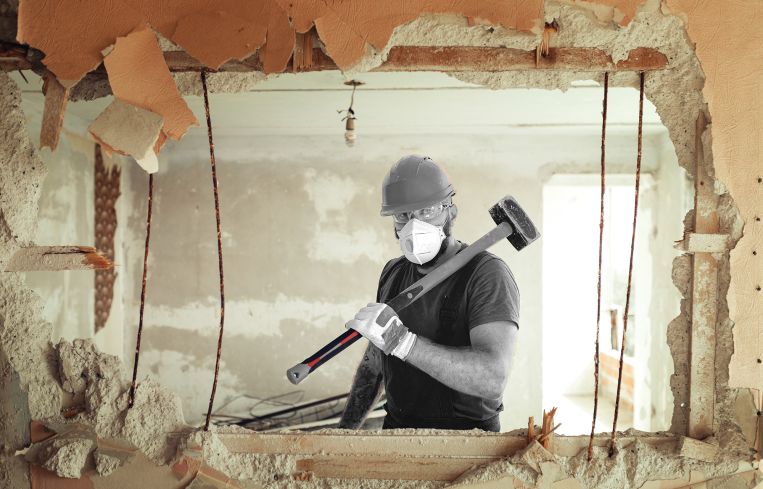Thinking About Starting a Construction Firm in New York City? Think Twice.
A notorious scaffolding law — plus workers’ comp costs, byzantine regulations and insurance premiums — make it unusually difficult
By Larry Getlen July 29, 2025 12:00 pm
reprints
Why would anyone want to start a construction company in New York City in 2025?
The question is not rhetorical.
While exact numbers are hard to come by, asking people connected with construction in New York City, “Do you know of any new construction companies that began operations in the city over the past few years?” tends to return blank stares and a quizzical, “Now that you mention it…” before the vacuum becomes apparent.
And while starting any business comes with challenges — and starting a construction company has always had an extra level of barriers due to the complexity of operations — the dearth of new companies in New York is showing that perhaps the level of challenge has risen beyond what is practical.
“We haven’t seen a significant amount of new construction businesses in the New York City metro area since COVID,” said Chris Kelly, an accounting and audit partner at the accounting firm Anchin, Block & Anchin (better known as Anchin) and a member of the firm’s architecture and engineering and construction industry groups.
“There was a lot of growth in the open-shop marketplace in the New York City area, primarily driven by the residential market, from 2012 to 2019,” Kelly said. “But we have not seen a lot of new contractors [since], whether it’s clients we’re working with or new names on our general contractors’ accounts payable ledgers. We just haven’t seen that much entrepreneurial spirit in the construction marketplace since COVID.”
Starting any construction business has long required a healthy dose of capital and the patience of a saint to wade through the paperwork involved in adhering to copious city, state and federal regulations. But the entire process has become more expensive, arduous and time consuming since the pandemic.
The most bank-breaking expense faced by New York construction companies is the high cost of insurance, made so in part by the state’s Labor Laws 240 and 241, commonly known as the Scaffold Law. That holds contractors legally liable for certain types of worker injuries regardless of who’s at fault, even if the worker’s own negligence caused the injury.
A coalition of industry groups called Scaffold Law Reform estimates on its website that the Scaffold Law costs “$785 million in public dollars every year.”
It’s the only law of its kind in the nation, and the lawsuits and settlements it drives have led New York insurers to send construction premiums sky high.
“These laws are probably some of the toughest in the country, and that has translated into very high insurance premiums,” said Michael J. Vardaro, managing partner at construction law firm Zetlin & De Chiara. “For a new firm to get an insurance policy in New York, it’s much more expensive than other jurisdictions.”
Law firm Wood Smith Henning & Berman noted that in 2010, the Empire State Chapter of the Associated Builders and Contractors found that “about 4 percent of the cost of a $100 million project in New York would go toward workers’ compensation, general liability and excess insurance.” That same expense in New Jersey, Connecticut or Pennsylvania at the time was only 2.5 percent.
By 2020, the law firm noted, that expense in New York had jumped to approximately 8.5 percent. By 2024, it hit 12.5 percent.
Vardaro notes that his clients in other areas react with shock when confronted with the insurance expense required to build in New York City.
“Our work spans the country,” said Vardaro. “We’ve dealt with firms focused in the South, and they’re interested in doing projects up in New York because their clients are doing work up here. They try to procure some insurance, and it’s like, ‘Oh, my god, what is this? These numbers are crazy.’ ”
Kelly said that Anchin’s construction clients are dealing with 10 to 15 percent price increases for their insurance every year, and this complaint is echoed throughout the industry.
“I was just talking to an insurance broker earlier today, and he told me that insurance could be 10 percent of the revenue on some contracts in New York. That same insurance outside of New York is 3 percent,” said Fred Ackerman, accounting and audit partner at Anchin and co-practice leader of the firm’s architecture and engineering and construction industry groups. “That’s a tremendous difference just by moving interstate, because there’s not that many carriers that will insure in New York. There’s a handful, but they don’t like the laws — the Scaffold Law in particular.”
This leads to another major problem in New York City construction: the limited number of insurance carriers that will even write any policies.
Liberty Mutual recently announced a halt to covering New York construction work for contractors based in Connecticut or New Jersey.
Asked for comment, Liberty Mutual replied, “We can confirm a recent business decision to apply a New York construction exclusion for contractors based in New Jersey and Connecticut effective Aug. 1 and Nov. 1, respectively, for new business, and Nov. 1 in both states for renewals. … The insurance market in New York state continues to be extremely challenging. Elevated loss trends, high costs impacted by inflation and other economic factors, as well as inconsistencies with state laws and regulations have resulted in the difficult but necessary decision to stop writing this business.”
The company further explained that this applies to its “U.S. retail markets” business line and not its “global risk solutions” line, which means it applies to small commercial contractors, but not the “middle and large commercial insurance market.” More bad news for small, emerging businesses.
Overall, finding insurance companies willing to cover the construction industry seems harder than ever.
An October 2020 article in Insurance Journal about efforts to reform the Scaffold Law quotes Tom Stebbins, executive director of the Lawsuit Reform Alliance of New York, in noting that for general liability policies, “over the past few years, it’s gotten demonstrably worse. More and more insurers have left New York entirely. They will no longer write construction policies.”
A summer 2023 article in Risk & Insurance noted that due to rising claims as a result of the Scaffold Law, “the cost of insuring a construction project is significantly higher in New York than in any other state, and many insurers are unwilling to offer primary coverage or sufficient limits. Those that do require deductibles of more than $1 million.”
And insurance distributor and broker CRC Group noted in April 2024 that “the vague nature of the law has created an atmosphere of open-ended liability for construction companies, and produced a challenging environment for insurance agents as they seek to find affordable protection for their contractor clients. … More and more insurers have exited New York entirely and will no longer write construction policies there.”
Donal Sutton is a principal and co-founder of Darby Construction Services, a Manhattan-based company that formed in 2018 and specializes in interior fit-outs. Asked for the most challenging aspect of launching his company, Sutton doesn’t hesitate to immediately name insurance as the primary culprit.
“It was hard to get an insurance policy that was affordable,” Sutton said. “The first year’s insurance policy was based on a gross sales volume of around $1 million, and the insurance cost was upward of 10 percent. When you’re bidding a job, you’re bidding against all the other general contractors, and everyone’s carrying around 2.5 to 3 percent, so you’re losing money straightaway for the first couple years.”
Sutton also said that if he was starting his business today, he expects he would be paying around 10 to 15 percent more than he did in 2018.
“It would be very, very expensive,” said Sutton. “You just have to grin and bear it, and not make ends meet for the first couple of years.”
CO Adaptive is a Brooklyn-based architecture firm founded by Ruth Mandl and Bobby Johnston in 2011, and based out of the Brooklyn Navy Yard. In 2021, the pair added a construction arm to their business called CO Adaptive Building.
Given that they weren’t starting from scratch, they have had an easier time getting the construction arm up and running than a brand-new business might have.
“Since launching as a design-build practice, overall CO Adaptive’s experience has been positive,” Mandl said in an email to Commercial Observer. “There has been great efficiency added to our processes, construction schedules and cost-control measures by bringing construction services in-house.”
But, even with their advantages, the city’s bizarre insurance situation due to the Scaffold Law often places them in a bind.
Insurance is required for companies at all levels of the construction process, including subcontractors. But some subcontractors’ policies include exclusions that shift Scaffold Law liability to the general contractor, meaning that contractors have to know exactly what sort of insurance every subcontractor is carrying, and may not be able to work with their desired subcontractors if those companies can’t afford, or chose not to carry, full coverage.
“To us, the hardest thing about insurance has been vetting all of our trade partners’ insurance policies to ensure that they do not have labor law exclusions. This is an essential ingredient of protection for ourselves and our clients,” said Mandl. “This coverage is not cheap for smaller [subcontractors], and we have heard from trade partners that in many instances it is cost prohibitive for them to have it.”
New construction companies in New York are also stymied by the cost of worker’s compensation insurance, which is higher than both worker’s compensation insurance premiums for construction companies in other states and rates here in New York for other industries.
According to the digital insurance agency WorkCompOne, workers’ comp costs can be estimated using the following formula: (Annual employee payroll / 100) x workers’ compensation insurance rate = estimated workers’ compensation cost.
The “insurance rate” differs by state and by industry. In New York, a state-level board sets base rates for each industry. Insurers then have some leeway in setting their own rates based on the base rates, but those must be approved by the same board.
As an example of how much more this insurance costs construction businesses in New York than almost any other business — using the highest rates approved by the state for each industry, according to the website workerscompensationshop.com — the insurance rate for masonry construction in New York is around 40 percent higher than for solar energy contractors. It’s almost 200 percent higher than for painting contractors, and over 500 percent higher than for machine shop workers.
In Iowa, meanwhile, the comparative rate for masonry construction is almost 300 percent lower than the same rate in New York.
Larger companies can mitigate some of this expense by self-insuring, but that option is open only to companies with institutionally deep pockets, which means that most startups would rarely have the option.
And, while navigating the prohibitive cost environment, owners of new construction companies in New York City also have to deal with a byzantine regulatory environment.
Tom Curran is a partner at the global law firm Duane Morris who counts construction as one of his practice areas. Asked if he happened to know of any new construction companies that started up in New York over the past few years, none came to mind.
“I can only assume they’re starting on a smaller level and slowly building themselves up,” Curran said of fresh New York City-based construction companies today. “I think there were more a few years back.”
Curran notes that owners of new construction companies have a mass of regulations to deal with on “the local, state and federal levels,” and that each regulation often presents time-consuming requirements.
“Pick up the building code sometime. It’s huge,” said Curran. “It’s like the Internal Revenue Code — a very complex set of rules and regulations that is subject to periodic change, and that anybody building in New York is absolutely required to adhere to.”
On top of massive insurance costs and a slew of industry-specific regulations, new construction businesses still have the same basic business needs as new businesses in any other location or industry, some of which grew more challenging due to the pandemic.
“COVID changed a lot,” said Curran. “There was a real crimp on basic construction supplies, which played to the favor of larger, established firms. Supply companies made the very logical decision of, ‘I sell X worth of dollars to ABC Corp. every year, and I’m going to make sure they have me as their supplier going forward.’ Newer firms didn’t have that kind of muscle. So that was a large challenge.”
Despite all this, though, the fact remains that buildings will always be built in New York City, and new people and businesses will always come along with dreams of building them. Curran, while noting that there will never be a time when building here is absent of challenges, is optimistic that when it comes to new builders in New York, where there is a will, there will always be a way.
“It’s a statement of fact on the order of ‘water is wet’ that it is not easy to start up any kind of business in New York City in terms of the barriers that may confront you,” said Curran. “But New York has a sustainability that seems to outlast the ability of rules and regulations to stifle it. There’s a vitality here. People rise to the challenge. There’s always a need for things to be built in New York, you know.”
Larry Getlen can be reached at lgetlen@commercialobserver.com.


